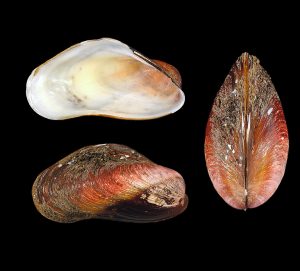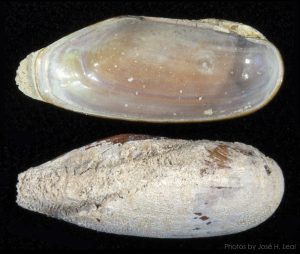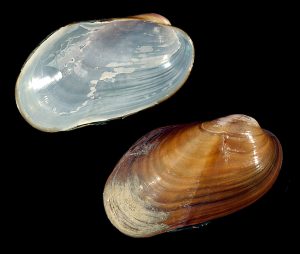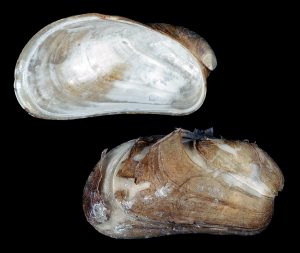Family Modiolidae
Shell size to 65 mm; shell similar to Modiolus americanus, but with umbones smaller and not swollen, and coarse, thick, brown periostracum with long filaments. Color brownish with oblique whitish ray on older specimens; umbones white.
Read MoreShell size to 100 mm; shell mussel-shaped, trigonal. Sculpture of fine growth lines. Umbones swollen, not terminal (away from end of shell). No hinge teeth. Periostracum heavy, sometimes hair-like. Color light-brown with blush of rose (concentrated on umbones) and purple streaks.
Read MoreShell size to 35 mm; shell elongate, cylindrical, tapering at posterior end, thin-walled. Two grooves run obliquely from the shell beak to the posterior (rear) area of each valve. The posterior half of each valve can be heavily encrusted with a relatively soft, calcium-carbonate deposit. This deposit projects backward, forming a spatula-like structure that reaches beyond the posterior end of each valve. A rock-boring species, found in calcium carbonate substrates such as live or dead coral and mollusk shells. The second photo shows a Mahogany Date Mussel boring into the top valve of a Jewel bBx. All specimens from the Museum collection, all collected on Sanibel.
Read MoreShell size to 28 mm; shell small for family, elongate-ovate, inflated, thin-walled, with taller section on posterior one third. Hinge with slight expansion under umbo. Color brown, with very sharp, slanted line separating lighter color posterior end from darker anterior end. Nacreous bluish inside.
Read MoreShel size to 18 mm; shell elliptical, externally sculpted with concentric ridges. Beaks rolled inward. Periostracum grayish-brown. This species is a borer living in dead shells and small coral heads. The shell illustrated was collected within a Kitten Paw, Plicatula gibbosa, shell. From the East End of Sanibel Island, Florida, by Jim Scatterday.
Read More



